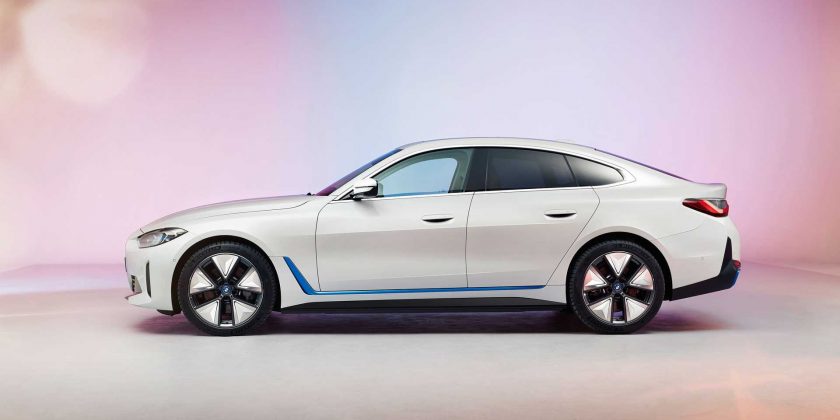Now we know it doesn’t ride on a bespoke EV platform, but the i4 is really impressive on paper.
Until now, driving enthusiasts who wanted to switch to an EV really had a very limited selection of vehicles to opt for: the best choice for the keen driver looking to go electric is the Porsche Taycan, but it is quite expensive (although slightly more attainable in base RWD form), or the Tesla Model 3 which drives fairly well, but it wasn’t necessarily designed to please driving enthusiasts.
Don’t get me wrong, the Model 3 is currently the best choice for someone who likes spirited driving but hates tailpipe emissions (and can’t afford a Taycan), but now there’s a new kid on the block that does have the power to upset the hierarchy. We are, of course, talking about the BMW i4, the newly revealed fully-electric version of the four-door 4 Series.
All we have to go on right now are preliminary estimates regarding its range, but an expected 590 km (367 miles) WLTP or 300 miles (482 km) EPA, it will, in theory, be a match for the Model 3. BMW may offer more than one battery pack option, though – we’ll have to wait and see, because the manufacturer will have several versions with varying power outputs (it would not be out of the question if the battery packs also differed from version to version).
For comparison, the Tesla Model 3, arguably the i4’s biggest rival right now, can go further on one charge, in its longest range versions. The Long Range AWD model has a claimed EPA range of 353 miles (568 km) or a WLTP range of 360 miles (580 km). Chances are the Tesla, whose weight in the same LR AWD configuration is 4,072 pounds (1,847 kg), will actually be a bit lighter than the BMW, which we predict might end up going past the 2-ton mark, or come very close to it.
Gallery: 2022 BMW i4
When it comes to power, though, the most powerful version of the i4 will have 523 horsepower (530 PS) and it will be able to sprint to 100 km/h (62 mph) from standstill in under 4 seconds – BMW has yet to provide the final figure. The quickest version of the Model 3, the Performance, has 450 horsepower and it reaches 100 km/h (62 mph) from nought in 3.3 seconds, but even if the i4 will be heavier, its extra power will give it an acceleration figure that is at least close to the Model 3’s (BMW is probably being conservative with its under 4-second estimate).
We expect the i4 to come with an 80 kWh battery pack that you’ll be able to charge at up to 150 kW via DC fast charger. This should put 100 km (62 miles) worth of range back into the battery in around 6 minutes or take the state of charge up to 80 percent in around 30 minutes. By comparison, the Tesla Model 3’s biggest available battery pack is the 75 kWh pack, but thanks to new cells with 5 percent better energy density, which has grown to over 80 kWh, thus matching (or even surpassing) the BMW for outright capacity. When it comes to charging, the Model 3 peaks at 120 kW.
We’ll have to wait for the final range claims from BMW, yet since the i4 travels slightly less with an almost identical battery (on the EPA combined cycle), it looks like the Model 3 uses its electrons slightly more efficiently. Tesla claims that a Model 3 LR AWD sips just 29 kWh/100 miles, and while we don’t have any exact figures, based on the range estimate and rumors about the i4 having an 80 kWh battery, we estimate it is slightly higher than the Tesla’s.
BMW will gradually trickle-feed us information about the i4 and when we have all of the specs, we’ll look at these two vehicles again. As things stand right now, it’s pretty clear the i4 was benchmarked to at least be a match for the Model 3, but the thing is, if it’s also a more engaging drive, some potential buyers will still get it even though the Tesla is the outright range and semi-autonomous driving leader.
Probably the best part about the i4 is that it will be fairly similarly priced to the Model 3. Expect it to cost somewhere in the $50,000 range, although we don’t expect it to go too far south of that value; we say it will carry a $50,000+ window sticker when it launches later this year. What do you think? Is the i4 the first worthy Model 3 rival, or is it just another half-baked attempt by an OEM that didn’t even bother to use a bespoke EV platform.
Source: Read Full Article






